check engine LOTUS ELISE 2005 Owners Manual
[x] Cancel search | Manufacturer: LOTUS, Model Year: 2005, Model line: ELISE, Model: LOTUS ELISE 2005Pages: 205, PDF Size: 4.51 MB
Page 4 of 205
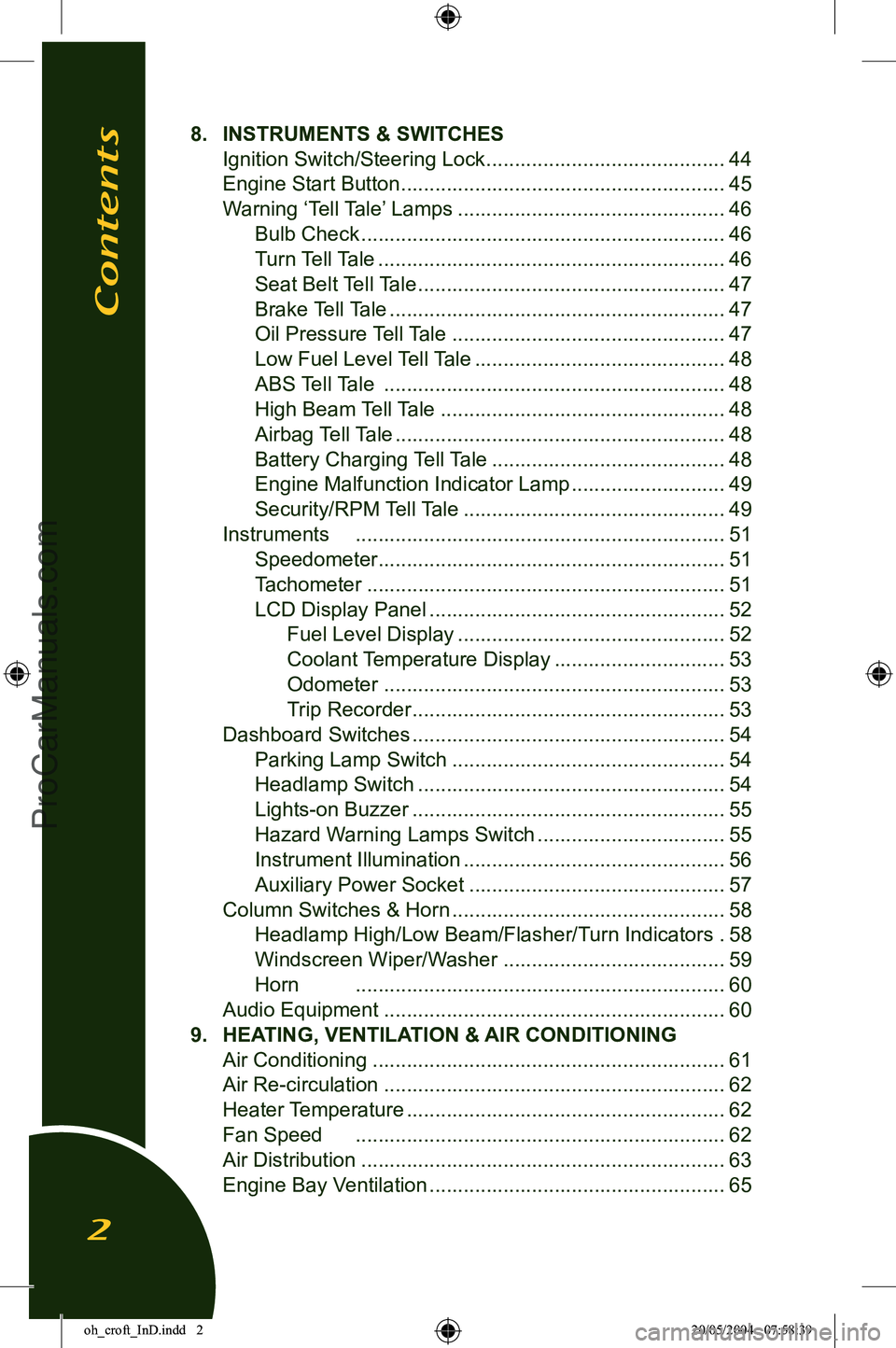
8. INSTRUMENTS & SWITCHES
Ignition Switch/Steering Lock ..........................................
44
Engine Start Button .........................................................
45
Warning âTell Taleâ Lamps ...............................................
46
Bulb Check ................................................................
46
Turn Tell Tale .............................................................
46
Seat Belt Tell Tale ......................................................
47
Brake Tell Tale ...........................................................
47
Oil Pressure Tell Tale ................................................
47
Low Fuel Level Tell Tale ............................................
48
ABS Tell Tale ............................................................
48
High Beam Tell Tale ..................................................
48
Airbag Tell Tale ..........................................................
48
Battery Charging Tell Tale .........................................
48
Engine Malfunction Indicator Lamp ...........................
49
Security/RPM Tell Tale ..............................................
49
Instruments .................................................................
51
Speedometer .............................................................
51
Tachometer ...............................................................
51
LCD Display Panel ....................................................
52
Fuel Level Display ...............................................
52
Coolant Temperature Display ..............................
53
Odometer ............................................................
53
Trip Recorder .......................................................
53
Dashboard Switches .......................................................
54
Parking Lamp Switch ................................................
54
Headlamp Switch ......................................................
54
Lights-on Buzzer .......................................................
55
Hazard Warning Lamps Switch .................................
55
Instrument Illumination ..............................................
56
Auxiliary Power Socket .............................................
57
Column Switches & Horn ................................................
58
Headlamp High/Low Beam/Flasher/Turn Indicators .
58
Windscreen Wiper/Washer .......................................
59
Horn .................................................................
60
Audio Equipment ............................................................
60
9. HEATING, VENTILATION & AIR CONDITIONING
Air Conditioning ..............................................................
61
Air Re-circulation ............................................................
62
Heater Temperature ........................................................
62
Fan Speed .................................................................
62
Air Distribution ................................................................
63
Engine Bay Ventilation ....................................................
65
Contents
2
oh_croft_InD.indd 220/05/2004 07:58:39ProCarManuals.com
Page 5 of 205
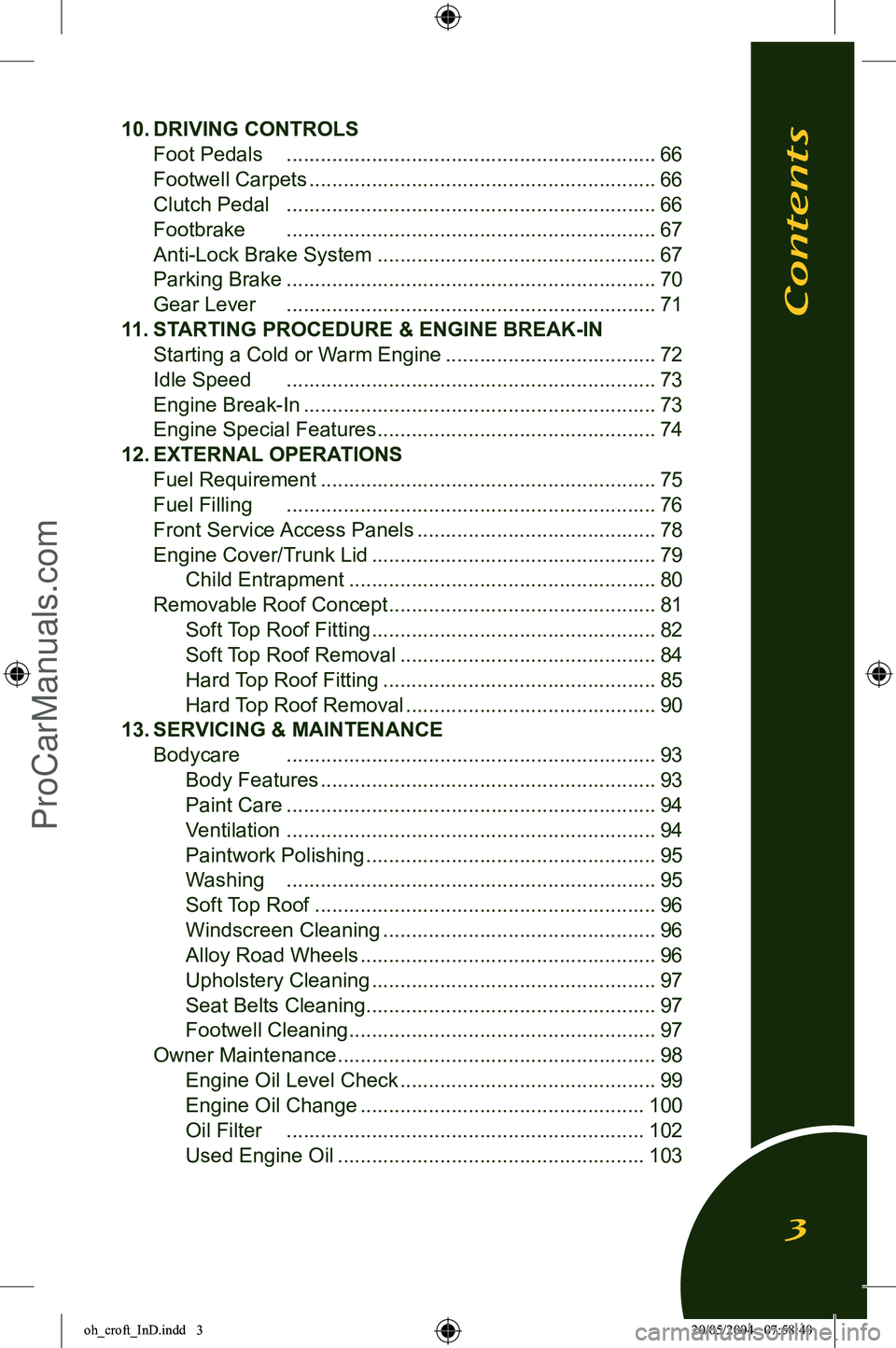
10. DRIVING CONTROLS
Foot Pedals .................................................................
66
Footwell Carpets .............................................................
66
Clutch Pedal .................................................................
66
Footbrake .................................................................
67
Anti-Lock Brake System .................................................
67
Parking Brake .................................................................
70
Gear Lever .................................................................
71
11. STARTING PROCEDURE & ENGINE BREAK-IN
Starting a Cold or Warm Engine .....................................
72
Idle Speed .................................................................
73
Engine Break-In ..............................................................
73
Engine Special Features .................................................
74
12. EXTERNAL OPERATIONS
Fuel Requirement ...........................................................
75
Fuel Filling .................................................................
76
Front Service Access Panels ..........................................
78
Engine Cover/Trunk Lid ..................................................
79
Child Entrapment ......................................................
80
Removable Roof Concept ...............................................
81
Soft Top Roof Fitting ..................................................
82
Soft Top Roof Removal .............................................
84
Hard Top Roof Fitting ................................................
85
Hard Top Roof Removal ............................................
90
13. SERVICING & MAINTENANCE
Bodycare .................................................................
93
B
ody Features ...........................................................93
Paint Care .................................................................
94
Ventilation .................................................................
94
Paintwork Polishing ...................................................
95
Washing .................................................................
95
Soft Top Roof ............................................................
96
Windscreen Cleaning ................................................
96
Alloy Road Wheels ....................................................
96
Upholstery Cleaning ..................................................
97
Seat Belts Cleaning ...................................................
97
Footwell Cleaning ......................................................
97
Owner Maintenance ........................................................
98
Engine Oil Level Check .............................................
99
Engine Oil Change ..................................................
100
Oil Filter ...............................................................
102
Used Engine Oil ......................................................
103
Contents
3
oh_croft_InD.indd 320/05/2004 07:58:40ProCarManuals.com
Page 14 of 205
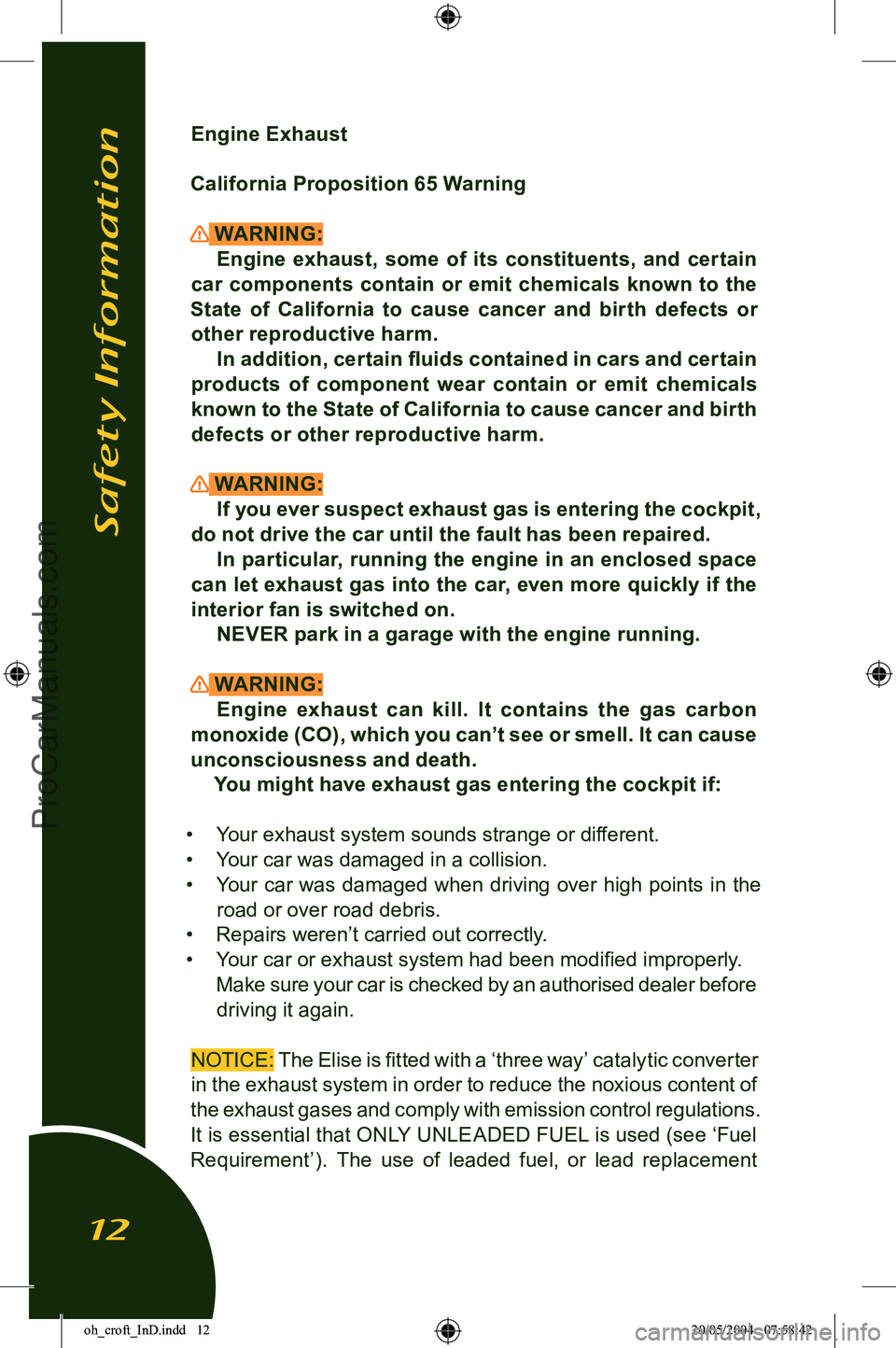
Engine Exhaust
California Proposition 65 Warning
WARNING: Engine exhaust, some of its constituents, and certain
car components contain or emit chemicals known to the
State of California to cause cancer and birth defects or other reproductive harm. In addition, certain ï¬uids contained in cars and certain
products of component wear contain or emit chemicals
known to the State of California to cause cancer and birth
defects or other reproductive harm.
WARNING: If you ever suspect exhaust gas is entering the cockpit,
do not drive the car until the fault has been repaired.
In particular, running the engine in an enclosed space
can let exhaust gas into the car, even more quickly if the interior fan is switched on. NEVER park in a garage with the engine running.
WARNING:Engine exhaust can kill. It contains the gas carbon
monoxide (CO), which you canât see or smell. It can cause
unconsciousness and death. You might have exhaust gas entering the cockpit if:
⢠Your exhaust system sounds strange or different.
⢠Your car was damaged in a collision.
⢠Your car was damaged when driving over high points in the
road or over road debris.
⢠Repairs werenât carried out correctly.
⢠Your car or exhaust system had been modiï¬ed improperly.
Make sure your car is checked by an authorised dealer before
driving it again.
NOTICE: The Elise is ï¬tted with a âthree wayâ catalytic converter
in the exhaust system in order to reduce the noxious content of
the exhaust gases and comply with emission control regulations.
It is essential that ONLY UNLEADED FUEL is used (see âFuel Requirementâ). The use of leaded fuel, or lead replacement
Safety Information
12
oh_croft_InD.indd 1220/05/2004 07:58:42ProCarManuals.com
Page 15 of 205
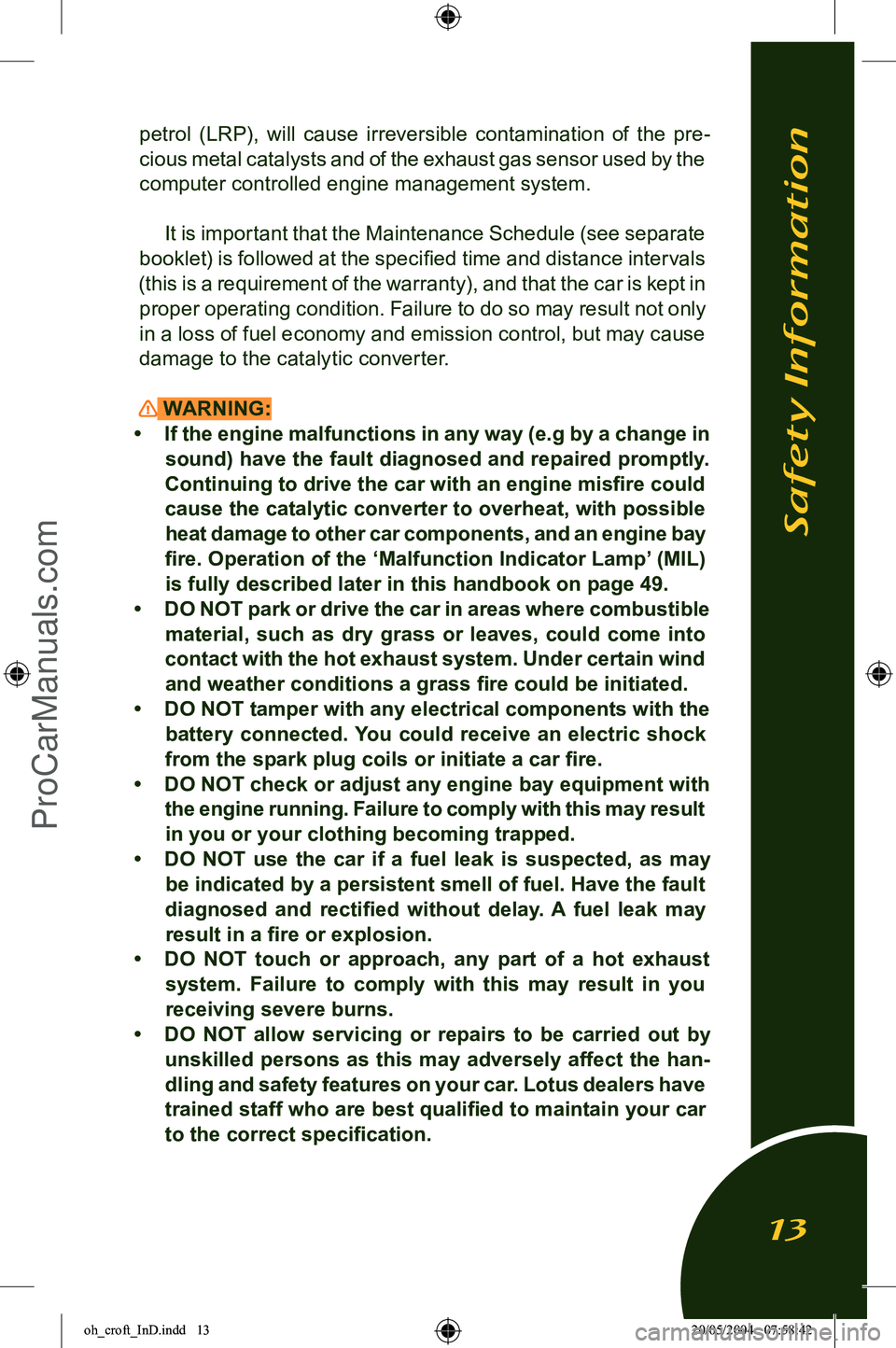
petrol (LRP), will cause irreversible contamination of the pre-
cious metal catalysts and of the exhaust gas sensor used by the
computer controlled engine management system.
It is important that the Maintenance Schedule (see separate
booklet) is followed at the speciï¬ed time and distance intervals
(this is a requirement of the warranty), and that the car is kept in proper operating condition. Failure to do so may result not only
in a loss of fuel economy and emission control, but may cause damage to the catalytic converter.
WARNING:
⢠If the engine malfunctions in any way (e.g by a change in sound) have the fault diagnosed and repaired promptly.
Continuing to drive the car with an engine misï¬re could cause the catalytic converter to overheat, with possible heat damage to other car components, and an engine bay
ï¬re. Operation of the âMalfunction Indicator Lampâ (MIL)
is fully described later in this handbook on page 49.
⢠DO NOT park or drive the car in areas where combustible material, such as dry grass or leaves, could come into
contact with the hot exhaust system. Under certain wind and weather conditions a grass ï¬re could be initiated.
⢠DO NOT tamper with any electrical components with the battery connected. You could receive an electric shock
from the spark plug coils or initiate a car ï¬re.
⢠DO NOT check or adjust any engine bay equipment with the engine running. Failure to comply with this may result
in you or your clothing becoming trapped.
⢠DO NOT use the car if a fuel leak is suspected, as may be indicated by a persistent smell of fuel. Have the fault
diagnosed and rectiï¬ed without delay. A fuel leak may result in a ï¬re or explosion.
⢠DO NOT touch or approach, any part of a hot exhaust
system. Failure to comply with this may result in you
receiving severe burns.
⢠DO NOT allow servicing or repairs to be carried out by unskilled persons as this may adversely affect the han
-
dling and safety features on your car. Lotus dealers have
trained staff who are best qualiï¬ed to maintain your car
to the correct speciï¬cation.
Safety Information
13
oh_croft_InD.indd 1320/05/2004 07:58:42ProCarManuals.com
Page 16 of 205
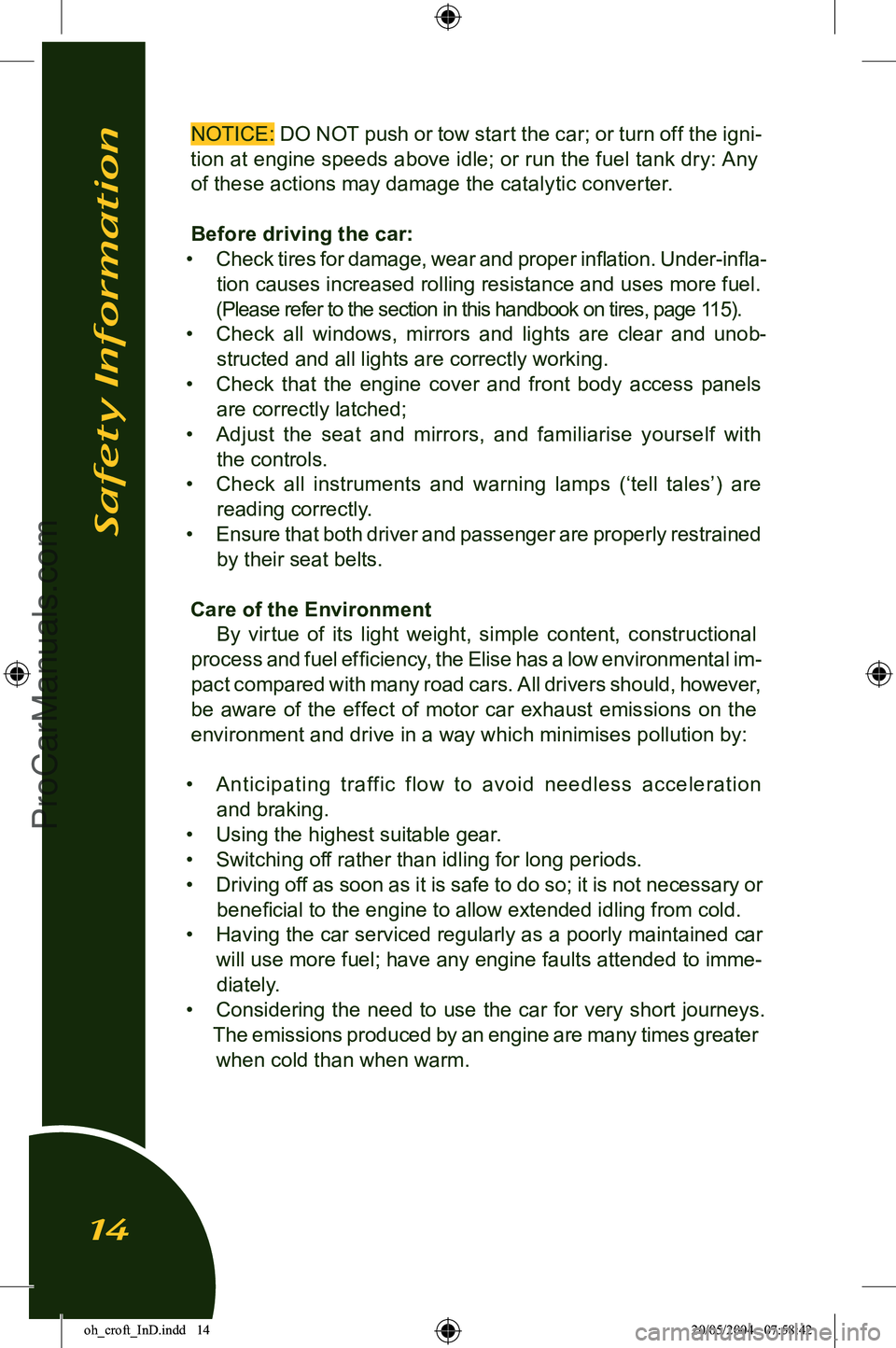
NOTICE: DO NOT push or tow start the car; or turn off the igni-
tion at engine speeds above idle; or run the fuel tank dry: Any of these actions may damage the catalytic converter.
Before driving the car:
⢠Check tires for damage, wear and proper inï¬ation.
Under-inï¬a-
tion causes increased rolling resistance and uses more fuel.
(Please refer to the section in this handbook on tires, page 115).
⢠Check all windows, mirrors and lights are clear and unob
-
structed and all lights are correctly working.
⢠Check that the engine cover and front body access panels
are correctly latched;
⢠Adjust the seat and mirrors, and familiarise yourself with
the controls.
⢠Check all instruments and warning lamps (âtell talesâ) are reading correctly.
⢠Ensure that both driver and passenger are properly restrained
by their seat belts.
Care of the Environment By virtue of its light weight, simple content, constructional
process and fuel efï¬ciency, the Elise has a low environmental im
-
pact compared with many road cars. All drivers should, however,
be aware of the effect of motor car exhaust emissions on the
environment and drive in a way which minimises pollution by:
⢠Anticipating traffic flow to avoid needless acceleration
and braking.
⢠Using the highest suitable gear.
⢠Switching off rather than idling for long periods.
⢠Driving off as soon as it is safe to do so; it is not necessary or beneï¬cial to the engine to allow extended idling from cold.
⢠Having the car serviced regularly as a poorly maintained car will use more fuel; have any engine faults attended to imme
-
diately.
⢠Considering the need to use the car for very short journeys.
The emissions produced by an engine are many times greater
when cold than when warm.
Safety Information
14
oh_croft_InD.indd 1420/05/2004 07:58:42ProCarManuals.com
Page 34 of 205
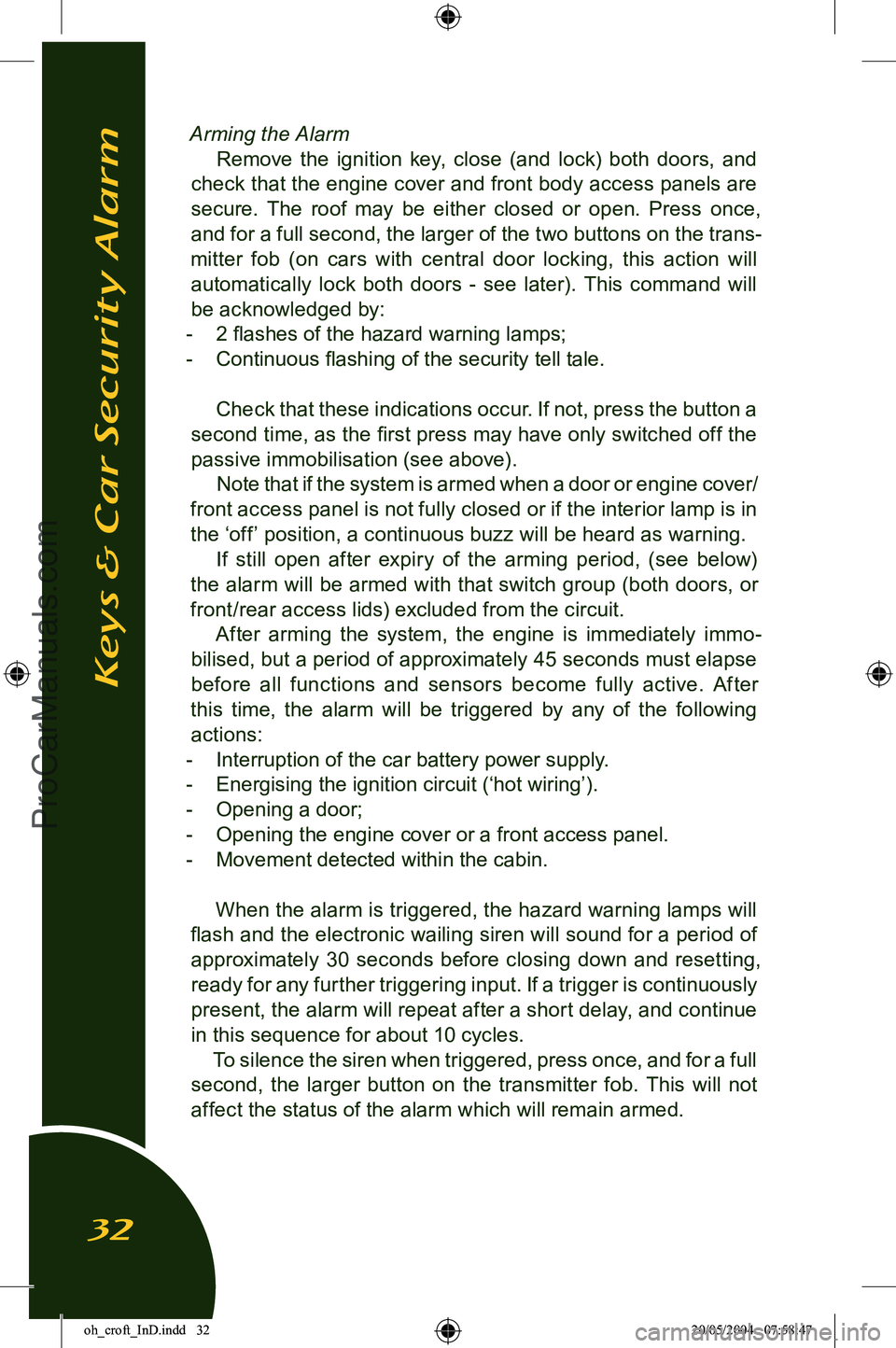
Arming the AlarmRemove the ignition key, close (and lock) both doors, and
check that the engine cover and front body access panels are
secure. The roof may be either closed or open. Press once, and for a full second, the larger of the two buttons on the trans
-
mitter fob (on cars with central door locking, this action will automatically lock both doors - see later). This command will
be acknowledged by:
- 2 ï¬ashes of the hazard warning lamps;
- Continuous ï¬ashing of the security tell tale.
Check that these indications occur. If not, press the button a
second time, as the ï¬rst press may have only switched off the passive immobilisation (see above). Note that if the system is armed when a door or engine cover/
front access panel is not fully closed or if the interior lamp is in the âoffâ position, a continuous buzz will be heard as warning. If still open after expiry of the arming period, (see below)
the alarm will be armed with that switch group (both doors, or
front/rear access lids) excluded from the circuit.
After arming the system, the engine is immediately immo
-
bilised, but a period of approximately 45 seconds must elapse
before all functions and sensors become fully active. After
this time, the alarm will be triggered by any of the following actions:
- Interruption of the car battery power supply.
- Energising the ignition circuit (âhot wiringâ).
- Opening a door;
- Opening the engine cover or a front access panel.
- Movement detected within the cabin.
When the alarm is triggered, the hazard warning lamps will
ï¬ash and the electronic wailing siren will sound for a period of approximately 30 seconds before closing down and resetting, ready for any further triggering input. If a trigger is continuously
present, the alarm will repeat after a short delay, and continue
in this sequence for about 10 cycles. To silence the siren when triggered, press once, and for a full
second, the larger button on the transmitter fob. This will not affect the status of the alarm which will remain armed.
Keys & Car Security Alarm
32
oh_croft_InD.indd 3220/05/2004 07:58:47ProCarManuals.com
Page 40 of 205
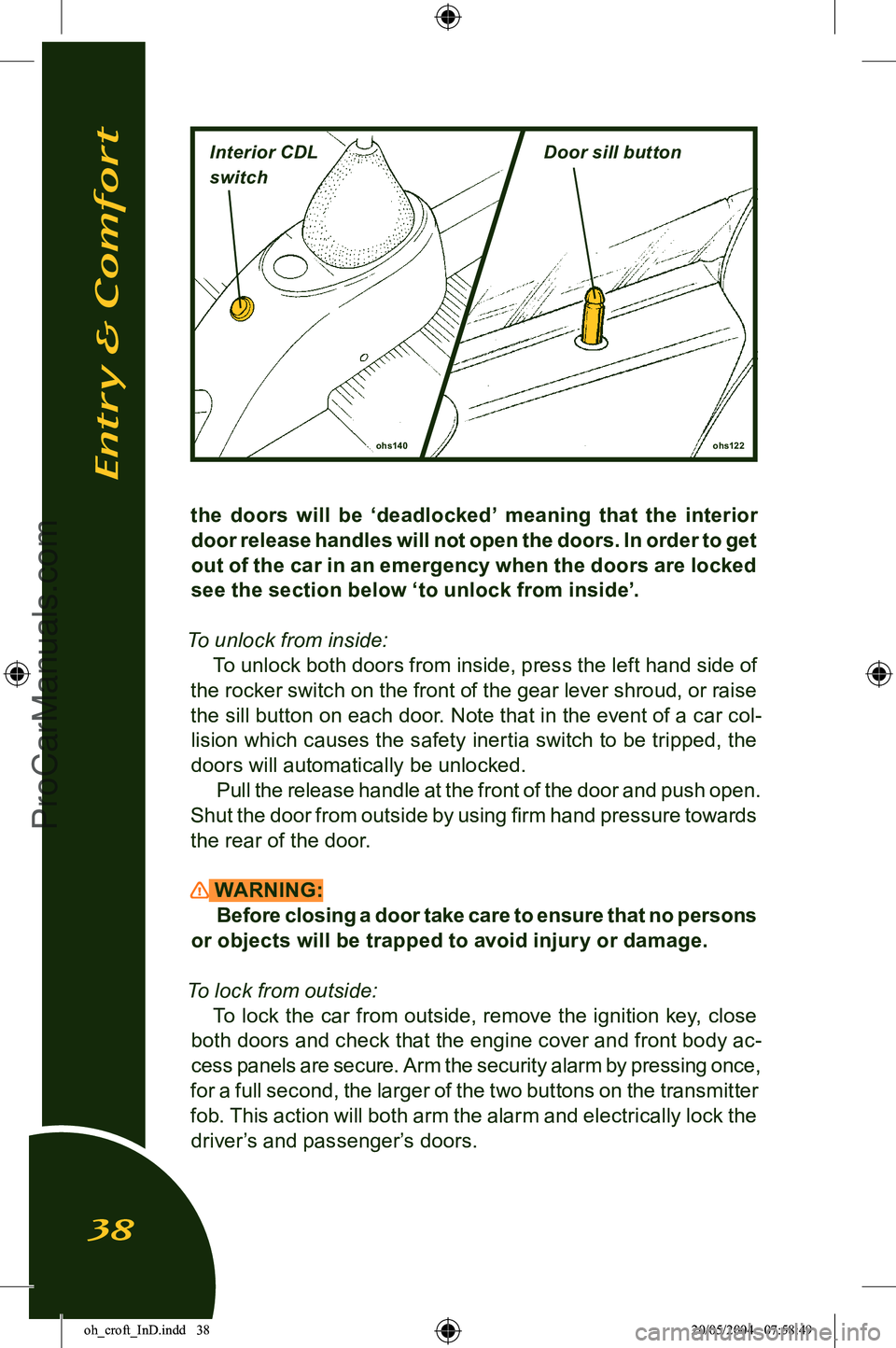
the doors will be âdeadlockedâ meaning that the interior door release handles will not open the doors. In order to get
out of the car in an emergency when the doors are locked
see the section below âto unlock from insideâ.
To unlock from inside: To unlock both doors from inside, press the left hand side of
the rocker switch on the front of the gear lever shroud, or raise
the sill button on each door. Note that in the event of a car col
-
lision which causes the safety inertia switch to be tripped, the doors will automatically be unlocked.
Pull the release handle at the front of the door and push open.
Shut the door from outside by using ï¬rm hand pressure towards the rear of the door.
WARNING: Before closing a door take care to ensure that no persons
or objects will be trapped to avoid injury or damage.
To lock from outside: To lock the car from outside, remove the ignition key, close
both doors and check that the engine cover and front body ac
-
cess panels are secure. Arm the security alarm by pressing once,
for a full second, the larger of the two buttons on the transmitter
fob. This action will both arm the alarm and electrically lock the driverâs and passengerâs doors.
ohs122
ohs140
Entry & Comfort
38
Interior CDL
switchDoor sill button
oh_croft_InD.indd 3820/05/2004 07:58:49ProCarManuals.com
Page 48 of 205
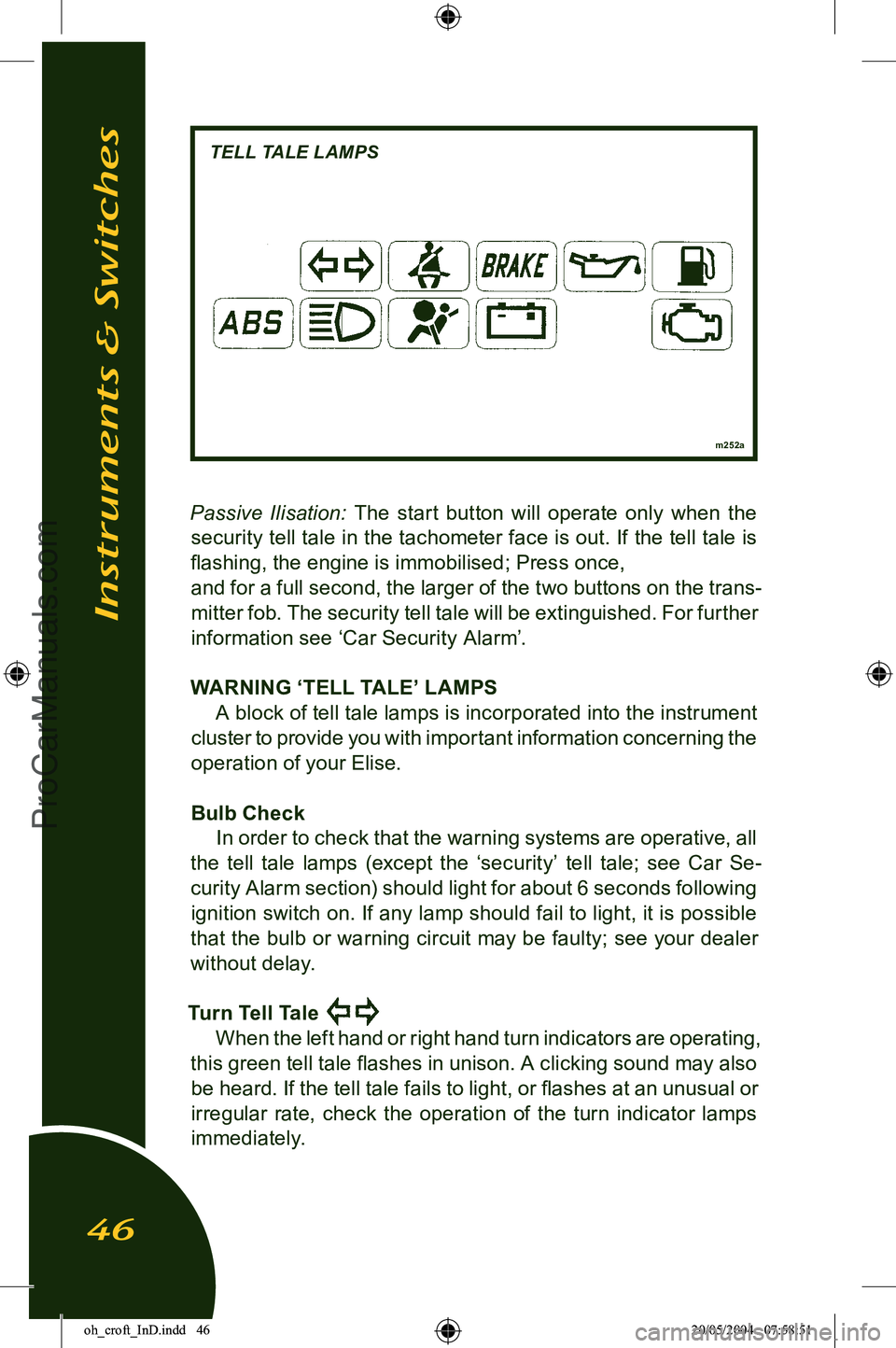
Passive Ilisation: The start button will operate only when the
security tell tale in the tachometer face is out. If the tell tale is
ï¬ashing, the engine is immobilised; Press once,
and for a full second, the larger of the two buttons on the trans
-
mitter fob. The security tell tale will be extinguished. For further
information see âCar Security Alarmâ.
WARNING âTELL TALEâ LAMPS A block of tell tale lamps is incorporated into the instrument
cluster to provide you with important information concerning the
operation of your Elise.
Bulb Check In order to check that the warning systems are operative, all
the tell tale lamps (except the âsecurityâ tell tale; see Car Se
-
curity Alarm section) should light for about 6 seconds following ignition switch on. If any lamp should fail to light, it is possible
that the bulb or warning circuit may be faulty; see your dealer
without delay.
Turn Tell Tale
When the left hand or right hand turn indicators are operating,
this green tell tale ï¬ashes in unison. A clicking sound may also be heard. If the tell tale fails to light, or ï¬ashes at an unusual or
irregular rate, check the operation of the turn indicator lamps
immediately.
m252a
Instruments & Switches
46
TELL TALE LAMPS
oh_croft_InD.indd 4620/05/2004 07:58:51ProCarManuals.com
Page 49 of 205
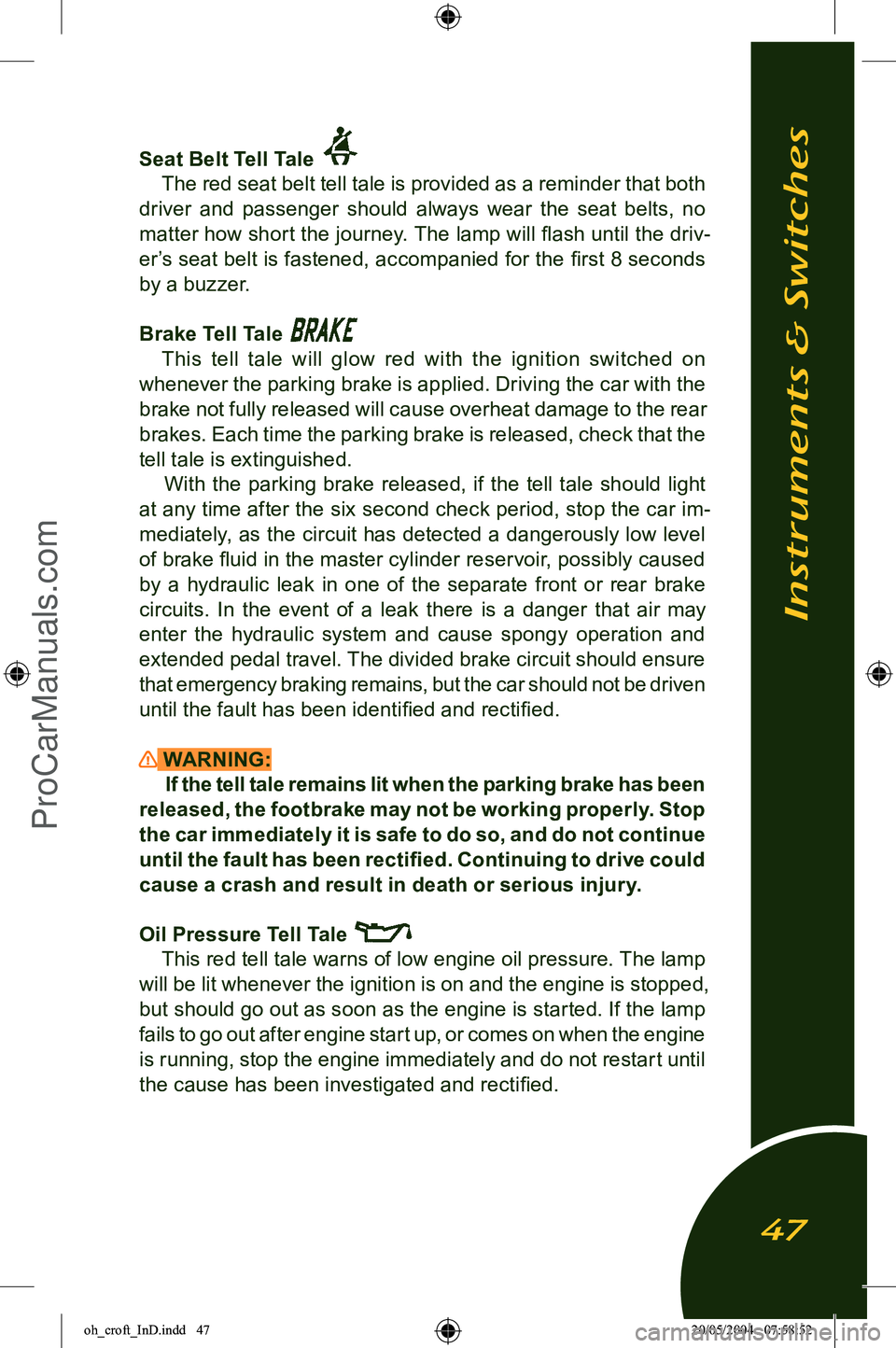
Seat Belt Tell Tale
The red seat belt tell tale is provided as a reminder that both
driver and passenger should always wear the seat belts, no
matter how short the journey. The lamp will ï¬ash until the driv
-
erâs seat belt is fastened, accompanied for the ï¬rst 8 seconds by a buzzer.
Brake Tell Tale
This tell tale will glow red with the ignition switched on
whenever the parking brake is applied. Driving the car with the brake not fully released will cause overheat damage to the rear
brakes. Each time the parking brake is released, check that the
tell tale is extinguished. With the parking brake released, if the tell tale should light
at any time after the six second check period, stop the car im
-
mediately, as the circuit has detected a dangerously low level of brake ï¬uid in the master cylinder reservoir, possibly caused
by a hydraulic leak in one of the separate front or rear brake
circuits. In the event of a leak there is a danger that air may enter the hydraulic system and cause spongy operation and
extended pedal travel. The divided brake circuit should ensure
that emergency braking remains, but the car should not be driven until the fault has been identiï¬ed and rectiï¬ed.
WARNING: If the tell tale remains lit when the parking brake has been
released, the footbrake may not be working properly. Stop
the car immediately it is safe to do so, and do not continue until the fault has been rectiï¬ed. Continuing to drive could cause a crash and result in death or serious injury.
Oil Pressure Tell Tale
This red tell tale warns of low engine oil pressure. The lamp
will be lit whenever the ignition is on and the engine is stopped, but should go out as soon as the engine is started. If the lamp
fails to go out after engine start up, or comes on when the engine is running, stop the engine immediately and do not restart until
the cause has been investigated and rectiï¬ed.
Instruments & Switches
47
oh_croft_InD.indd 4720/05/2004 07:58:52ProCarManuals.com
Page 50 of 205
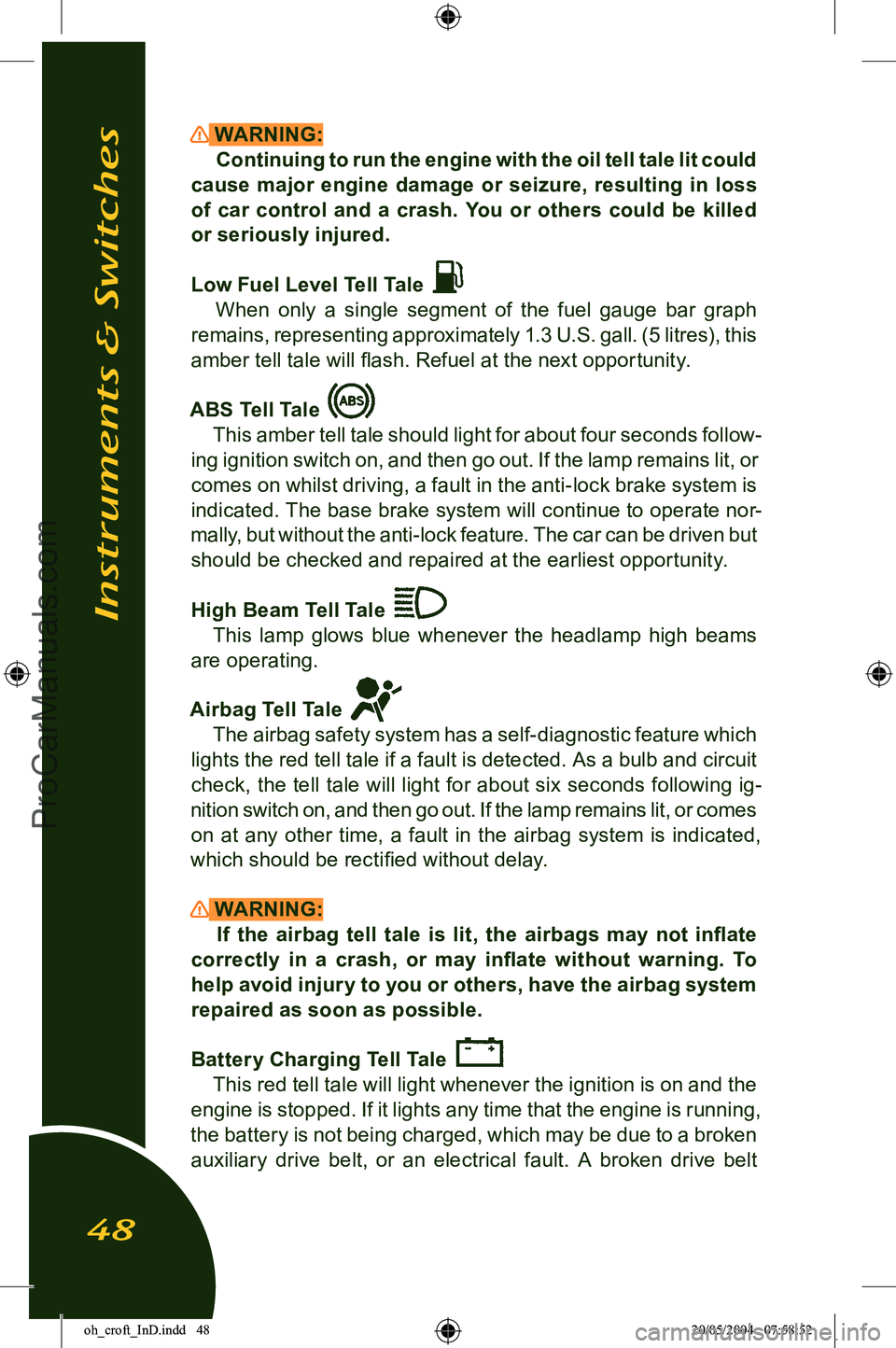
WARNING:Continuing to run the engine with the oil tell tale lit could
cause major engine damage or seizure, resulting in loss
of car control and a crash. You or others could be killed
or seriously injured.
Low Fuel Level Tell Tale
When only a single segment of the fuel gauge bar graph
remains, representing approximately 1.3 U.S. gall. (5 litres), this
amber tell tale will ï¬ash. Refuel at the next opportunity.
ABS Tell Tale
This amber tell tale should light for about four seconds follow-
ing ignition switch on, and then go out. If the lamp remains lit, or
comes on whilst driving, a fault in the anti-lock brake system is
indicated. The base brake system will continue to operate nor
-
mally, but without the anti-lock feature. The car can be driven but should be checked and repaired at the earliest opportunity.
High Beam Tell Tale
This lamp glows blue whenever the headlamp high beams
are operating.
Airbag Tell Tale
The airbag safety system has a self-diagnostic feature which
lights the red tell tale if a fault is detected. As a bulb and circuit
check, the tell tale will light for about six seconds following ig
-
nition switch on, and then go out. If the lamp remains lit, or comes on at any other time, a fault in the airbag system is indicated,
which should be rectiï¬ed without delay.
WARNING: If the airbag tell tale is lit, the airbags may not inï¬ate
correctly in a crash, or may inï¬ate without warning. To
help avoid injury to you or others, have the airbag system repaired as soon as possible.
Battery Charging Tell Tale
This red tell tale will light whenever the ignition is on and the
engine is stopped. If it lights any time that the engine is running,
the battery is not being charged, which may be due to a broken
auxiliary drive belt, or an electrical fault. A broken drive belt
Instruments & Switches
48
oh_croft_InD.indd 4820/05/2004 07:58:52ProCarManuals.com